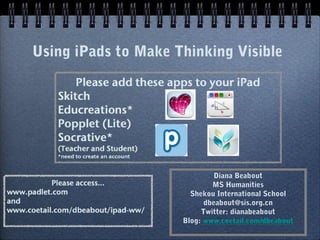Using iPads to Make Thinking Visible
- 1. Using iPads to Make Thinking Visible Diana Beabout MS Humanities Shekou International School dbeabout@sis.org.cn Twitter: dianabeabout Blog: www.coetail.com/dbeabout
- 2. Focus As educators, we are constantly assessing our students’ understanding of their learning to inform instruction and evaluation. When we can see and hear how they are processing and making meaning of concepts and skills, we can provide more targeted instruction and support for their success. In this session we will explore ways teachers and students can use iPads to demonstrate and document thinking and learning.
- 3. Background: -taught Social Studies, Language Arts and ESL in the United States for 16 years. -2nd year at SIS -enrolled in COETAIL course -currently teaching MS Humanities -grade 6 students have been 1:1 ipads since December 2012 Making Thinking Visible: -students have to show us their thinking & learning so we can adjust instruction and provide targeted support -we’ve always done this, with or without digital tools -I will share some examples of how I’ve used a few apps and online resources for informal assessment of students (individuals and classes) http://www.flickr.com/photos/32066106@N06/4885853065/
- 4. SKITCH A photo annotating app Task: After a study of the influences of ancient Roman culture on modern life, students were asked to take two photos (with their iPad) of examples of Roman cultural influences in their homes and communities. Then annotate the photo using Skitch including the following information: location of photo, description of photo, how item is related to ancient Roman culture. *I used this task to assess students’ ability to apply to information to a real-world example.
- 8. Educreations recordable interactive whiteboard app recordable interactive whiteboard app Task: As we were studying factors that effect the spread of beliefs and ideas (‘grows’ & ‘slows’), students were give 30 minutes to find two images (one to represent a ‘grow’ and one to represent a ‘slow’) and use Educreations to present the two images with an explanation of how they represented the concept. *I used this informal assessment to assess how well students could explain the concept in their own words.
- 9. Educreations recordable interactive whiteboard app recordable interactive whiteboard app Alternative Apps Note: There is no ability to re-record audio Show Me (free) without starting over. Screen Chomp (free) Explain Everything (paid) Example 1: From her presentation, I could assess that this student had a good grasp of the concept as she explained both slides thoroughly in her own words. VIDEO AVAILABLE ON NEXT SLIDE
- 10. Educreations recordable interactive whiteboard app recordable interactive whiteboard app Example 2: This student explained choice of images and his explanations also demonstrated he has a good grasp of the concepts. However, I noticed he used a few words incorrectly (assassination and abandon). VIDEO AVAILABLE ON NEXT SLIDE
- 11. Educreations recordable interactive whiteboard app recordable interactive whiteboard app Example 3: Although the images and explanations illustrated the concept, this student just repeated examples used in class (as we studied Christianity in Ancient Rome). He would need to apply the concept in a different way for me to feel confident in his understanding of it. VIDEO AVAILABLE ON NEXT SLIDE
- 12. Popplet *An interactive graphic organizer *Available as an app on iPad (Lite version is free/Paid version is US$4.99) *Web based version also available. (popplet.com) I have students do brainstorming or organization of ideas on popplet so I can assess their organization and thought process and where there might be gaps.
- 13. Socrative student response system Free Teacher app and Student app for iPad Web based version (www.socrative.com) ) I use Socrative to create ) short quizzes, polls and exit ) tickets. Results are immediate and go into a spread sheet for further analysis of group and individual needs. There is also an option for ‘live results’ that can be displayed to the class (without identifying individual students).
- 14. Padlet (www.padlet.com) Formally known as Wall Wisher, Padlet is basically ‘digital paper’ where ‘digital sticky notes’ can be posted. A wall is created and then a link can be shared with participants. In addition to text, links and files can also be added to a ‘sticky note’. After going over the rubric for an upcoming project, students posted questions and concerns on this ‘padlet’. They did not have to put their name on their ‘post’ so students would feel comfortable posting their questions. I was then able to go in and sort the ‘posts’ and see what students needed further support and instruction in. I noticed a lot of questions about vocabulary in the rubric and some instructions. Questions about Big 6 Research Rubric http://padlet.com/wall/4q4z5d7nyl
- 15. EXPLORE How could I use one of these apps or resource to demonstrate and document student thinking and learning in my classroom?
- 16. Considerations When to use? When would it be beneficial to use any of these apps &/or online resources? Workflow? How will I collect student products? (besides email) Shared Devices? How could I use any of these apps &/or online resources in a shared device setting?
- 17. THANK YOU! Diana Beabout MS Humanities Shekou International School dbeabout@sis.org.cn Twitter: dianabeabout Blog: www.coetail.com/dbeabout elearning.sis.org.cn

















